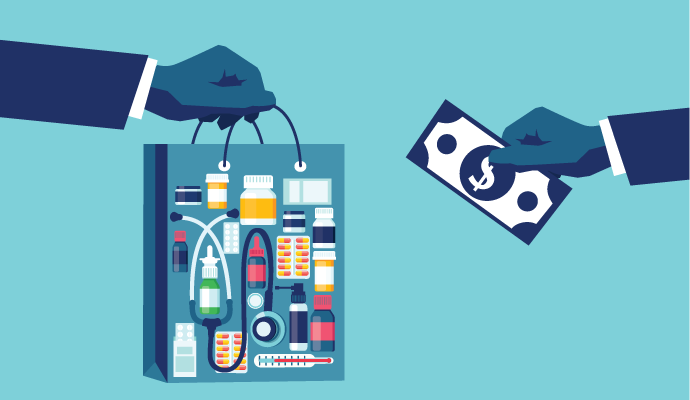How Could Drug Price Proposals Impact Pharma Company Profits?
Proposals to curb drug price increases will limit but not eliminate the profitability of pharmaceutical companies.

- The pharmaceutical industry could lose $1 trillion in overall revenue and still remain as one of the most lucrative industries in the country, according to research conducted in partnership between West Health Policy Center and the Johns Hopkins Bloomberg School of Public Health.
This suggests that recent policy proposals to quell prescription drug costs may not be as disastrous as some pharma companies may say, the researchers noted.
Prescription drug costs have ballooned to unsustainable amounts, medical professionals and patients agree, proving to be extremely unaffordable for most patients. Data has shown that medications necessary for treating certain chronic diseases, like diabetes, are up by nearly $6,000, and that’s just referring to the out-of-pocket costs that patients see.
These insurmountable costs are troublesome for public and private payers and crippling to patients, many of whom choose to forego medication access due to costs.
With most patients agreeing that rising drug costs must prompt government intervention, healthcare policymakers have put forward a number of options to quell the cost of medications.
Prominently, the Department of Health & Human Services (HHS) has developed the International Pricing Index (IPI), which would tie drug costs to those charged in similarly developed nations. Other drug price policy proposals aim to set benchmarks for how much manufacturers can charge for their drugs.
But that model and others aiming to cap prescription drug costs have fallen under pharmaceutical industry scrutiny. Specifically, industry leaders have suggested new policies would eat far into pharmaceutical company profit margins and cut into their investments for research and development (R&D).
This latest data from West Health and Johns Hopkins calls that industry outcry into question.
“The pharmaceutical industry has tried to instill fear in the American public that federal legislative proposals to reduce drug spending would threaten access to innovative life-saving drugs,” Timothy A. Lash, president of the West Health Policy Center, said in a statement. “West Health and John Hopkins’ findings clearly refute that claim. Large drugmakers are so profitable they could maintain their current investment in R&D — and their standing as the most profitable industry — even if they lose significant revenue.”
The researchers looked at 23 large drug manufacturers, selected based on their large market presence. Manufacturers included in the study mostly market brand-name drugs, are members of the PhRMA trade association, are publicly traded, and do not solely focus on orphan drugs.
The team looked at the return on invested capital (ROIC), a measure that considers a company’s net profits after taxes compared to its total invested capital. Between 2011 and 2019, the studied companies’ ROIC was 17.3 percent. When comparing pharmaceutical ROIC to that of other industries, the researchers found pharma to be the most profitable in the nation.
The Accommodation and Food Services and Professional, Scientific, and Technical Services industries were the second and third leading industries, coming in with 15.3 ROIC. Across all industries, the average ROIC was 11.5 percent.
Further analysis revealed that pharmaceutical companies could stand to lose $758 billion in sales revenue and still be the most profitable industry in the nation. And when adjusting for the entire pharmaceutical industry — the researchers only looked at 23 companies, or 72 percent of, the entire industry — the team found that the industry could lose $1.05 trillion in sales and still be the most profitable industry in the country.
And due to that financial flexibility, the researchers concluded that the pharmaceutical industry could withstand some of the cost-cutting policies that have recently been proposed.
“Given these findings, it’s likely large drug manufacturers could weather the reductions in drug spending scored under recent legislative proposals,” said Sean Dickson, director of health policy at West Health Policy Center and lead author for the analysis. “Even with lower revenues, these companies would still be very attractive investment options compared to other industries.”
Furthermore, these cuts in sales would not impact a pharmaceutical company’s attractiveness to investors. The researchers looked at an investing score known as a beta. A beta of 1 indicates a neutral investment – neither risky nor safe. A beta over 1 is known as a risky investment, and a beta between 0 and 1 are regarded as safe investments.
Should the recently floated drug pricing policy changes be made, the pharmaceutical industry could still boast a 0.61 beta score, which is higher than 75 percent of other industries’ scores.
“The large drug companies in our analysis were not a particularly risky investment, while smaller drug companies expectedly were, with a beta of .93,” said Jeromie Ballreich, director of the Masters in Health Economics and Outcomes Research program at Johns Hopkins Bloomberg School of Public Health and co-author of the analysis. “These findings refute a common critique that big drug companies need large profits given the high risk involved in developing prescription drugs.”
There were some issues with the study, stakeholders commented. For one, previous analysis of House Majority Leader Nancy Pelosi’s drug bill from the Congressional Budget Office stated that between eight and 15 new drugs would not be able to come to market under her plan.
PhRMA, the drug industry’s leading trade group, noted that excluding small biotech companies from the analysis was limiting. These companies are instrumental in drug development, which PhRMA maintains would be negatively impacted under drug price policy proposals.
Ultimately, stakeholders are debating the extent to which R&D will be impacted by new health policies. The West Health and Johns Hopkins data confirms that pharmaceutical companies will still earn high profits despite new policies. However, to what extent will those policies stunt companies’ abilities to invest in net drugs?
